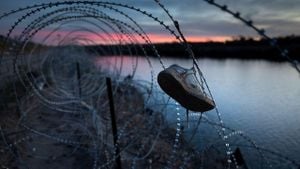Authorities from multiple countries recently unveiled details of one of the largest drug operations ever conducted, culminating in the seizure of over 1,400 metric tons of various drugs, including 225 metric tons of cocaine. Dubbed Operation Orion, this extensive crackdown involved the cooperation of 62 nations and has raised eyebrows with the reveal of new trafficking techniques exploited by drug cartels.
The urgency surrounding this international operation was underscored by Colombian Vice Admiral Orlando Enrique Grisales, who highlighted how between October 1 and November 14 of this year, authorities managed to disrupt extensive drug trafficking operations heading toward Australia. "These are unprecedented figures, especially the 225 tons of cocaine we managed to seize," Grisales stated during the official announcement. He noted this effort was significant not only because of the quantity of drugs confiscated but also due to the manner of transport utilized by traffickers.
Of remarkable note was the discovery of several so-called ‘narco subs’—semi-submersible vessels used for drug transport. These vessels pose considerable challenges to law enforcement agencies due to their low profiles, enabling them to remain nearly undetectable on the high seas. Grisales confirmed the interception of such vessels off the coast of Colombia, with one headed toward Australia carrying approximately 5 tons of cocaine.
This operation raises serious concerns for Australia, where illicit cocaine shipments have soared due to the drug's increasing demand and high street prices. Reports suggest cocaine can fetch up to $240,000 per kilogram on Australian streets, significantly more than the price per kilo seen elsewhere, creating incentives for traffickers to risk employing more innovative methods of transport. Grisales remarked, "The prices are much higher in Australia, driving the cartels to find new ways to deliver their product," explaining why these routes are becoming more common.
Historically, these narco submarines emerged as operational tools for Colombian drug traffickers in the late 1990s, as cartels sought to circumvent intensified law enforcement efforts. The Colombian Navy has emphasized the ingenuity and adaptability of these vessels, which often can cover vast distances without needing to refuel, projecting them as formidable assets for traffickers.
"These sophisticated vessels, some measuring between 10 and 25 meters long, are engineered to evade detection," said Captain Manuel Rodríguez, commander of Colombia's anti-narcotics unit. He noted the presence of advanced engineering allowing these vessels to travel nearly 10,000 miles before refueling challenges the forces seeking to combat this burgeoning network of drug distribution. Rodríguez explained, "It’s not just about intercepting—it's about tracking down these operations long before the drugs reach their destination. Cooperation was the key to this operation's success. We had aircraft and frigates from multiple countries actively contributing to our efforts."
The operation has certainly made waves within the global anti-narcotics community, cultivating significant partnerships among law enforcement from regions such as the US, Europe, and parts of South America. Indeed, over 400 individuals were apprehended amid this six-week crackdown, reflecting the broader aim to dismantle not just the means of transport but the entire network sustaining the drug trade.
"We’re dealing with well-organized crime networks now. It isn’t just isolated cartels; there are collaborations among groups from Mexico, Colombia, Ecuador, and beyond," Grisales mentioned, highlighting the evolution of cartel operations and the complicated pathways of trafficking.
Besides the apprehensions of individuals involved, the operation also addressed the interception of communications and the seizure of illegal arms linked to these trafficking networks. The collaborative nature of Operation Orion emphasizes the global commitment to intercepting these criminal enterprises wherever they may be based.
The headway gained during the operation will undoubtedly present long-term challenges to drug trafficking routes. Recent trends have shown increasing amounts of cocaine startlingly involved globally; the UN Office on Drugs and Crime estimated production reached approximately 2,700 tons last year alone, with Colombia still at the forefront as the world’s top producer.
"This operation is expected to have lasting effects on curtailing the flow of cocaine, stopping a significant financial blow to these cartels," Captain Rodríguez stated, believing their considerable haul would significantly reduce overdose deaths, as he echoed sentiments shared by many health officials across affected nations.
Looking onward, there is shared optimism among officials about employing advancements like artificial intelligence to improve drug detection and response strategies, honing efforts to mitigate illegal movements on this scale. "AI's implementation could revamp how we profile and monitor shipping containers and ports," Rodríguez stated. He posed it as part of the strategy moving forward to combat this global issue effectively.
With the international community rallying around the intelligence and resource-sharing aspects of Operation Orion, they have shown promise for sustained cooperative efforts against growing and increasingly sophisticated drug trafficking networks.



